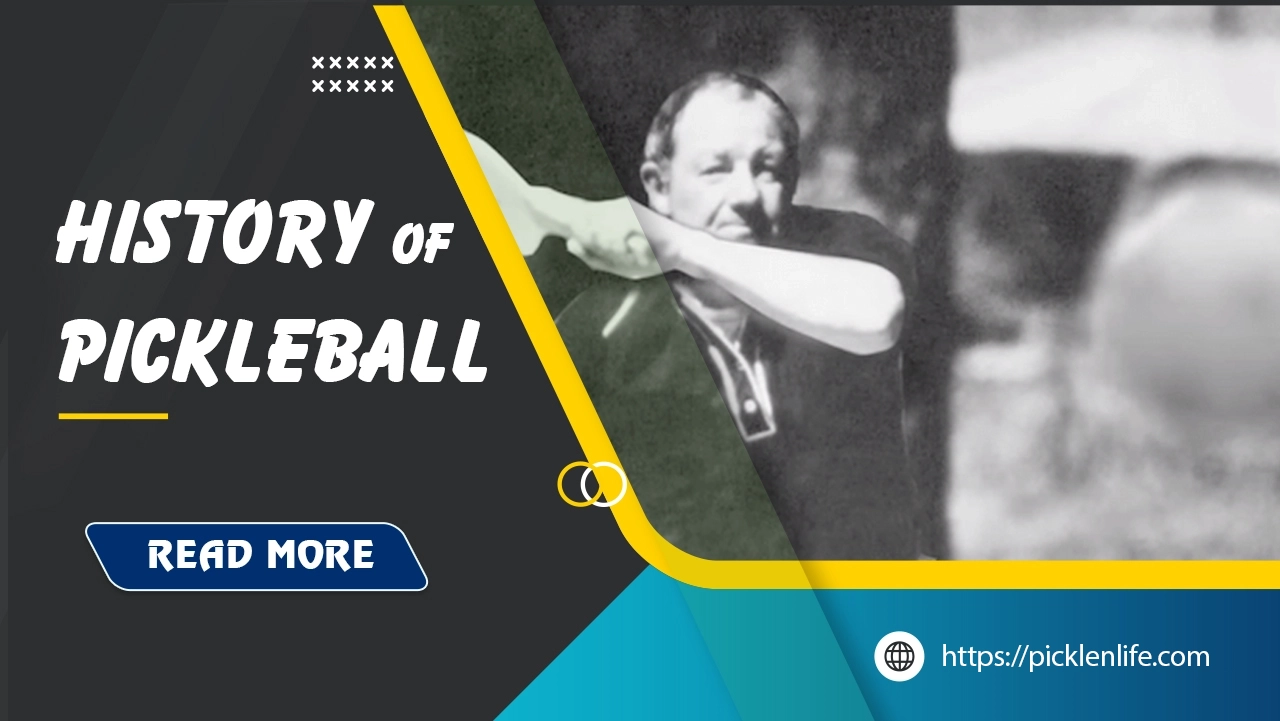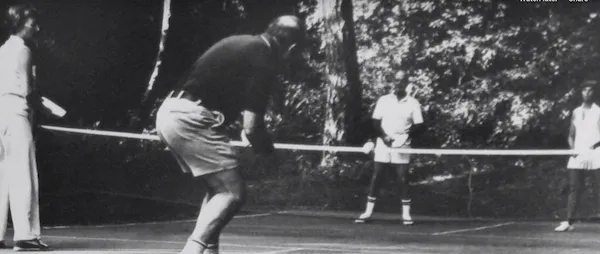History of Pickleball: From Backyard Game to Global Phenomenon
In recent years, a unique sport has gained immense popularity, capturing the hearts of people across generations and backgrounds alike. This sport is none other than pickleball a game that combines elements of tennis, badminton, and table tennis, but has a charm all its own. Its rise from humble beginnings to becoming a mainstay in communities has created a story that resonates with many. The history of pickleball is not just about its rules and regulations; it’s about community, innovation, and the joy of play. Let’s dive into the rich tapestry of this vibrant sport, tracing its origins, its evolution, and its current standing as one of the fastest-growing sports in the United States.

History of Pickleball – From humble beginnings to backyard craze (1965-1975)
In the summer of 1965, three friends Joel Pritchard, Bill Bell, and Barney McCallum set out to entertain their families on Bainbridge Island, Washington. Thus began the story of pickleball, a name that would soon become synonymous with fun and community spirit. On that sun-drenched afternoon, using an improvised combination of a badminton court, ping-pong paddles, and a perforated plastic ball, the trio laid the foundations of a sport that would grow exponentially.

The initial equipment was incredibly rudimentary; the makeshift paddles and balls bore little resemblance to modern versions. Yet, this simplicity was part of its magic. The game brought laughter and competition among families, sparking a movement that transformed the way people enjoyed leisure time. Imagine the sight: families gathering in backyards, laughter echoing, and friendly rivalries forming over an impromptu match. This vibrant image symbolizes the roots of pickleball an embodiment of accessibility and enjoyment.
In 1967, the first permanent court was constructed on Bob O’Brian’s property, marking a pivotal point in pickleball’s journey. No longer confined to backyards, the game began to take on a more structured nature. This transition paved the way for future developments in the sport, drawing attention from diverse groups and laying the groundwork for its formal recognition. By creating a dedicated space for play, O’Brian helped shape pickleball into an activity that could be consistently enjoyed and organized.
A summer afternoon on Bainbridge Island
The vibes of that summer afternoon resonate deeply within pickleball’s history. The creativity behind the game’s inception speaks to the core of what makes the sport special today. Not only did it start as a way to entertain families, but it also fostered a sense of community and connection. Pritchard and his friends may not have realized it at the time, but they were creating the first chapters of a sport that would bridge generational gaps and invite everyone to join in the fun. As we delve deeper into its history, the passion and innovation of those early days will continue to shine through.
The name game: pickle boat or Pickles the dog?
One of the delightful mysteries surrounding pickleball is its name. Two main theories persist about how this playful name came to be: one involving a “pickle boat” and the other linked to Pritchard’s beloved dog, Pickles. Joan Pritchard, Joel’s wife, argues that the name derives from the term “pickle boat,” referring to the crew in rowing competitions where leftover oarsmen like the leftovers in a pickle jar formed a team. This theory emphasizes the sense of togetherness that characterizes the sport.

On the other side, there’s a more heartwarming narrative the possibility that pickleball was named after the Pritchards’ dog, Pickles, who enjoyed fetching stray balls while the game was played. This charming origin story has added a layer of personal connection for many players and fans alike. No matter which story holds the true origin of the name, it highlights the playful spirit of the game and the value of community involvement.
Creating a permanent home for pickleball
With the establishment of the first permanent court in 1967, pickleball began its journey from a casual backyard pastime to a recognized sport. Bob O’Brian’s initiative was instrumental in allowing for structured play, fostering a sense of legitimacy and community collaboration. This court became a gathering place where enthusiasts could refine their skills, form leagues, and engage in friendly competition.
The transformation from improvised play to organized events represents more than just physical courts; it signifies a pivotal moment in the emotional landscape of pickleball. Families and friends would come together, not just to play, but to bond, socialize, and create lasting memories. This is where the “people’s sport” aspect truly shines, demonstrating how pickleball serves as both a sporting competition and a social outlet.
Formalizing the fun: rules, equipment, and organization (1976-1999)
The evolution of pickleball continued as the game grew, leading to the establishment of standardized rules and equipment. In 1984, the formation of the United States Amateur Pickleball Association (USAPA) introduced the first official rulebook. This critical development marked a shift from informal backyard play to organized tournaments, allowing players of different skill levels to enjoy structured competition.
The first rulebook provided a framework for gameplay, creating a sense of familiarity and consistency among players. The chance to compete at a higher level called on those with a passion for the sport to step up their game. With traditional tennis and other racquet sports as benchmarks, the introduction of official rules added legitimacy to pickleball as it was gaining traction in various communities.
Establishing the rules of the game
As tournaments began to emerge, particularly the first known tournament at the South Center Athletic Club in Tukwila, Washington, in 1976, the burgeoning community of pickleball players sought unity through standardization. The meticulous documentation of game rules allowed the sport to be played uniformly across different locations, creating a unique fabric of tradition within the sport.
With events becoming more structured, competition encouraged players to refine their skills while discovering the thrilling nature of pickleball. The sport transformed into an arena showcasing dedication, camaraderie, and a shared passion for play.
The evolution of pickleball equipment
From the humble beginnings of makeshift ping-pong paddles, equipment like wooden paddles evolved into composite paddles, pioneered by Arlen Paranto in 1984. These advancements significantly affected gameplay, enhancing players’ abilities to control and maneuver the ball effectively.
Moreover, the development of specialized pickleballs catered specifically to the unique dynamics of the sport. By understanding the nuances of play, manufacturers created equipment that complemented the game’s evolving style. The transition from amateur setup to professional-grade gear opened doors for players to experiment with techniques and strategies that could elevate their performance.
Early tournaments and media attention
As pickleball gained momentum, media coverage began to play a pivotal role in its popularity. Articles in well-known publications like Tennis Magazine and the National Observer captured the interest of sports enthusiasts everywhere, illustrating the excitement surrounding the sport. This early media exposure positioned pickleball as more than just a backyard game; it was seen as a viable sport worthy of recognition.
With each tournament and feature, pickleball began to craft its identity. These early tournaments, marked by community engagement, fostered a competitive atmosphere that continued to develop the sport’s sense of prestige. Today, we see the fruits of this early growth reflected in the number of participants and the extensive networks built within these communities.
The senior boom and pickleball’s ascent (2000-2018)
The early 2000s marked a transformative period for pickleball, especially among senior communities. The sport resonated deeply with older adults, showcasing its accessibility and appeal. Retirement communities like The Villages in Florida became hotspots for pickleball, offering socializing and healthy competition in a low-impact setting.
A hit with seniors: pickleball finds its niche
Pickleball’s allure for seniors can be attributed to several factors. The sport’s low-impact nature minimizes the risks associated with joint strain and injuries. Additionally, its easily grasped rules mean that seniors can quickly learn the game, fostering a sense of accomplishment. The social aspect of pickleball, where players form friendships and connections, creates an environment that many seniors find appealing.
As many seniors began participating, communities noticed an increase in overall health and well-being due to pickleball’s physical benefits. The combination of cardiovascular exercise, social engagement, and mental stimulation has solidified its place as an effective recreational option for aging populations. The success of pickleball in these communities can only be described as a synaptic cadence of joy, sport, and fellowship.
Pickleball takes center stage: media exposure and national recognition
Media exposure heightened pickleball’s visibility, particularly with its feature on ABC’s “Good Morning America” in 2008. As national audiences were introduced to the game, it began to break free from being merely a regional pastime. The growing interest in pickleball pushed players to new levels and inspired local clubs to host larger, more organized tournaments.
The first USAPA National Tournament in 2009 was a pivotal moment, attracting competitors from the United States and Canada. Events of this magnitude showcased tangible growth within the sport, unlocking opportunities for aspiring players as it expanded its reach.
Expanding horizons: pickleball goes global
As pickleball’s popularity soared in the U.S., its global appeal caught on. The International Federation of Pickleball (IFP) was established in 2010, serving as a catalyst for international promotion and events. The introduction of competitions like the Bainbridge Cup allowed enthusiasts to showcase their talents on a global stage while cultivating a rich sense of worldwide community among players.
Countries such as Canada, Australia, and beyond began to embrace the sport, increasing its international footprint. This expansion highlighted the universal joy that pickleball brings to people of all cultures, further solidifying its identity as a beloved global sport.
The professional era: pickleball’s rise to prominence (2019-present)
As we entered the 2020s, pickleball continued its evolution into a professional sport, marked by the establishment of various professional tours and significant investments from athletes and celebrities alike.
The emergence of professional pickleball
The formation of professional tours, including the Association of Pickleball Professionals (APP) and the Professional Pickleball Association (PPA), provided a platform for competitive players to showcase their talents. With the potential for substantial prize money on the line, pickleball transitioned from an amateur pursuit to a viable profession for skilled players.
Celebrity involvement further bolstered the sport’s profile, capturing the attention of an entirely new audience. Noteworthy figures, like basketball star LeBron James, made investments in pickleball teams, illustrating the sport’s intersection with mainstream culture. This collaborative energy moved pickleball closer to its ambition of widespread recognition, attracting new players and enthusiasts eager to join the fun.
Major League Pickleball and the United Pickleball Association
The formation of Major League Pickleball (MLP) introduced a fresh, team-based format that captivated fans. This unique setup allows for dynamic competition and spectator engagement, distinguishing itself from more traditional formats in other sports.
In 2023, the landmark merger between the PPA and MLP led to the creation of the United Pickleball Association (UPA), aiming for unified organization and expansion. This strategic merger represents a pivotal moment in the sport’s landscape, offering promising prospects for growth across new markets notably in countries like Australia, India, and Canada.
Pickleball’s current state and future prospects
As pickleball continues to flourish, recent data solidifies its status as one of the fastest-growing sports in the United States. The allure of the game is reaching wider audiences, with growing interest for potential inclusion in the Olympic Games. This legitimization would further elevate pickleball’s status and bring even more players into the fold.
Looking ahead, innovations in equipment, training methods, and technology promise to propel the sport into the future. The potential for data-driven training and analysis, while currently on the fringes, could radically change how players prepare and compete. As pickleball thrives, embracing such advancements will be crucial.
The pickleball community: more than just a game
Pickleball’s history cannot be defined solely by its rules or its structure; it is also about the community it has built. The game has become a social cornerstone, fostering connections and a sense of belonging among individuals of all ages.
The social and cultural impact of pickleball
One significant element of pickleball’s charm lies in its ability to forge connections. Whether it’s a group of friends finding a new pastime or families bonding over friendly matches, the impact goes beyond fun and fitness. Community building is intrinsic to what pickleball stands for.
Additionally, the health benefits of pickleball are profound. The physical activity encourages cardiovascular health, improves coordination, and serves as a stress-reliever. Mentally, participating in such a social sport promotes emotional well-being, combating feelings of isolation. This dual contribution to health and wellness makes pickleball not just a game, but a vital part of many players’ lives.
Challenges and controversies facing pickleball
Despite its many strengths, pickleball faces challenges. Noise complaints from nearby residents and court space allocation for enthusiasts have sparked disagreements in some communities. Additionally, concerns about injuries, particularly among older players, have prompted discussions around safety measures and court design.
Accessibility issues also remain pivotal, with various populations finding it challenging to participate due to limitations in community facilities or equipment availability. Addressing these controversies head-on will be crucial for the sport’s inclusive future.
Pickleball: a sport for the future
The growth trajectory of pickleball showcases an enduring legacy that transcends generations. With its emphasis on community, innovation, and inclusive participation, pickleball is more than just a passing trend it’s a permanent fixture in the sporting world. As it continues to evolve, there is enormous potential for growth, innovation, and a global legacy that brings people together through the joy of play.
In conclusion, the journey of pickleball from casual backyard games to a celebrated global sport illustrates the power of human connection and innovation. As players of all ages and backgrounds engage with the sport, they’ve not only created a competitive playground but have also forged a vibrant community that exemplifies the essence of play and camaraderie. With promising developments on the horizon, pickleball is poised to remain at the forefront of recreational sports for years to come.
